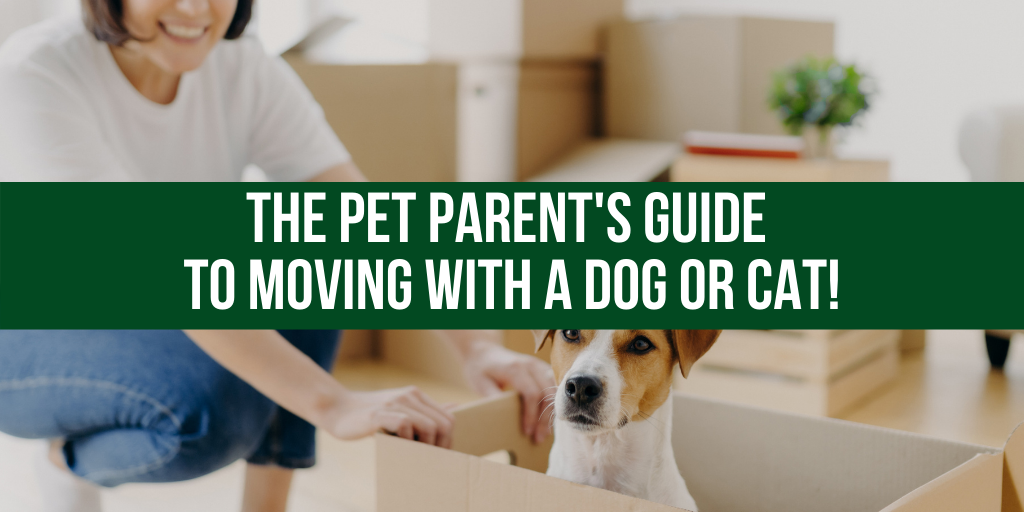
The stress of a big move can have a huge impact on your mental and emotional wellbeing. There’s all the planning, the organizing, the packing, and the chaos of the move itself. But you’re not the only one who might want to tear their hair out.
Cats and dogs are extremely susceptible to developing abnormal behaviors due to stress and anxiety caused by irregularities in their environment. And what is more irregular than moving to a strange place?
Fortunately, when you’re moving with a dog or cat there are several things you can do to keep them comfortable and healthy.
Potential Emotional Effects
Making the transition go as smoothly as possible will help prevent the emergence of the following behaviors.
Destructive behaviors: Although videos of dogs laying waste to an entire household are commonplace, they are often indicative of a more serious issue. Pets use destruction as a means of releasing pent-up anxiety and negative emotion.
Self-destructive behaviors: Unfortunately, pets often take their stress out on themselves. Cats and dogs are prone to overgrooming or chewing behaviors, which can result in bald patches and open wounds. Even if your pet has never shown this type of behavior before, it can be brought on due to moving-related stress.
Eating disorders: Animals don’t like eating if they don’t feel safe. Lack of proper nutrition can lead to drastic weight loss and other health issues.
Early aging and cognitive issues: Moves can be especially difficult on older pets. Suddenly being placed in a new location is often very traumatic and disorienting. This type of anxiety can speed mental and physical aging.
Elimination behavior: If your cat or dog suddenly starts relieving themselves around your new home, it might indicate they lack a sense of security.
Before Your Move
Moving with a dog or cat is all about thinking ahead. The more effort you put into the preparations, the easier the transition will be.
Acclimate Your Pet
Rather than shock your pet with a bunch of packing boxes and supplies. Introduce them to moving supplies gradually. As you go about decluttering your home and organizing for the move, leave your suitcase and boxes out in the open.
Place any pet carriers you plan to use in a visible place. Maybe even throw a few toys or a blanket inside to encourage exploration. Having these objects as a normal part of your pet’s environment will reduce their stress anxiety on moving day.
Train Your Pet
Do you plan to have the same house rules at your new place? Perhaps you’re moving into your partner’s home and they don’t want the dog on the couch. Ease your pet’s transition by introducing them to and reinforcing new behaviors before the move.
Confer With Your Vet
If you’re moving with pets it’s important to check in with your vet. They can provide you with mild tranquilizers and calming pills to keep your pets comfortable during a move. If you’re moving far, ask your vet if they have recommendations for a new veterinarian in your area.
It’s also a good idea to refill any pet prescriptions you might need while you’re getting settled.
Maintain Routine
Your pets will be shaken enough by all the chaos associated with the move, so it’s especially important to maintain stability wherever possible. Continue to exercise, feed, and groom your pets as you normally would. When moving with pets, their belongings should be one of the last things you pack.
Get the New Place Ready
One of the best tips for moving with a dog or cat is to get their new home ready beforehand. Establish a designated area for food, water, the litterbox, and their bed. If your pet is going to have access to a yard, make sure the pet door is already installed when they arrive.
Clean your new place thoroughly. Residual scents from previous pet owners can stress out your cats and dogs, leading them to develop abnormal behaviors. Do not, however, wash your own pet’s belonging, such as their bed.
Pack an Overnight Bag
When moving with your dog or cat you should always prepare an overnight bag with food, toys, treats, and anything else they might need during the first few days of the move.
Place extra towels and blankets in their normal sleeping space to pick up their scent. Then bring those along to place strategically around your new house. Smelling themselves in a strange place will help them acclimate quicker and accept the new location as their home.

During Your Move
The move itself is often the most stressful part of the entire transition. On the day of the move, you should try to keep your pet in a calm place away from the action. Make sure the room has everything they might need including food, water, piddle pads, or a litter box.
Take dogs on a walk to keep them away from the movers as they work. This is also great for getting rid of any excess energy they have before loading them into the car.
Make sure your pets have a light meal early in the day to decrease their chances of getting carsick. And always move your pets in your own vehicle, instead of a moving van or rental. The familiar smells will help keep their stress levels down.
Make sure all your pets are microchipped or wearing tags with updated information, especially if you plan to let them out during a longer move. When moving with a dog, always keep them on a leash during pit stops, to avoid them running off.
After Your Move
It is best to gradually introduce your pets to their new home, especially cats. One great tip for moving with cats is to keep them restricted to one room at a time. As they get more comfortable with their new surroundings you can open new parts of the house to let them explore.
One of the first things you must do is show your pets where to find their food and water. Cats need to know where their litterbox is located and dogs might require a bit of guidance navigating their new doggie door.
Be patient and do everything you can to make them feel safe and comfortable. Before you know it, they will be relaxed and accepting of their new home.
Moving With a Dog or Cat
Moving with a dog or a cat doesn’t have to be stressful. Make sure that you are planning ahead and taking steps to make their transition as comfortable as possible before, during, and after the move.
Contributed by: www.thestoragebox.com/

Thanks, Deb Rhodes
Look me up on Twitter @ckhomes4sale